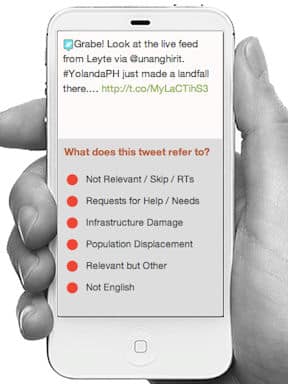The devastation wrought by Super-Typhoon Haiyan in the Philippines is the biggest test yet for the nascent technology of “artificial intelligence disaster response,” a phrase used by Patrick Meier, a pioneer in the field.
When disaster strikes, a flood of social media posts and tweets ensues. There is useful information in the data flood, but it is beyond the capacity of individuals and agencies to make effective and rapid use of it. Meier’s “Micromappers” system uses a multi-stage system to tackle the problem. Basically, it works like this:
- Scraper software, using an apriori set of terms and keywords, gathers a large universe of potentially relevant tweets and posts.
- Crowdsourced volunteers classify the tweets and posts into pre-determined categories
- Using a set of volunteer-classified tweets and posts, predictive models are developed that can rapidly classify large volumes of tweets and posts in real time, recording location information.
- Maps of critical rescue requirements are developed and updated, based on the tweet category and location information.
- Relief agencies use the maps to gain more definitive information about relief needs than they would get through official reports and their own agents.
Here’s an example of what the human volunteer classifier sees, using the Micromapper app:
Of course, the system relies on the availability of social media data, which, in turn, requires internet availability in the affected area. And large numbers of people have to have smartphones. That day is nearly here, even in developing countries. Vietnam, the next stop for Haiyan, has the second highest (after Russia) per-capita cell-phone subscription rate in the world. The destruction of communication facilities in a severe storm will indeed deprive the system of data in the hardest hit area, but a map with a notable blank spot, surrounded by an area of disaster reporting, is still highly informative.
Read more in the Nov. 11 Wall Street Journal and at micromapper.org
